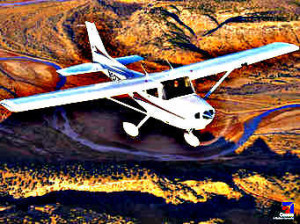The first time
The moment I had fantasized, been dreaming about, anticipating with sweaty palms – had arrived. Two weeks before, my world had rocketed out of humdrum grey with a mere phone call. I was poking around for a glider ride. (Missed out on that during a ski vacation out west, and I really wanted to do it.) Midwinter, not much glider activity. “You have your power license?” the man on the other end of the phone had asked. I was stunned, speechless. Women fly! Women fly! Not to overstate and get irreligious, but like Paul on the road to Tarsus, I right there experienced an epiphany. “Why, no…” I said – and he responded with “Come on down for an introductory flight!” OH yessss…
As I entered into this new world, I looked at the airspace around me. Not empty. Miles of cubic measures of atmosphere hummed invisibly with busy electrons… electrons passing along communications in strings of Arabic numerals – av-speak. It was the language of aviation: aircraft identifications, compass headings, altitudes – rattled off by male voices (a female voice was an anomaly back then) and I had to learn to understand it, and to speak it. I was breathless. It was all bizarre gibberish, of course. In we had climbed, closed the doors and buckled our belts. The panel full of dials in front of me was puzzling, intimidating, marked with lots of numbers – not my forte. Never mind. We were going to fly! And I was at the controls. We had first done a walk-around outside with explanations of things like hinged wing ailerons, flaps and tail rudder. And I’d seen the tiny hole, static port, on the side – that senses the pressure of passing wind. It works along with air ramming into the Pitot tube to calculate airspeed (that hangs pointing forward from a wing, providing a hidey-hole for bugs… when not flying. So at rest – cover it up .) “Ok… Listen” said the middle-aged, obviously impatient, baggy-eyed instructor. You think you wanna fly? Well then pay attention,” he barked. “Learn it right.” I chose not to be insulted. He explained the enigmatic dials, especially the turn coordinator. “Coordinate, coordinate, coordinate” he said –“with the ailerons and rudder I showed ya, keep that little ball centered, make all your movements smooth and together to get a propah turn,” he rumbled. “Use a light touch. Think fragile eggs. It will take lots of practice.” He continued. “To turn right, put some pressure on the right rudder with your right foot, and, with hands on the yoke at the same time, tilt it a bit to the right. When you get the aircraft turning like you want, stabilize its position – take the pressures off foot and yoke…. Now you’re what we call ‘established in the turn.’ See that little ball there? Keep it in the middle.” He pointed to a small round window showing a needle at its bottom that swung left and right, with a ball in the center at its base. The turn coordinator. (In principal, the ball worked like a carpenter’s level.) “But also pull back a little bit on the yoke” he said.
(Yolk? Looked to me like a half steering wheel). “The turn adds weight to the plane, so it wants to sink. It’s physics. You know – centrifugal force.” I only knew centrifugal force from driving around a curve too fast. I nodded, “Right, ok.” Oh no… I’m supposed to understand and do this? I can’t fake it! Slippery little weasel, that plane… wobbling, bobbling and weaving up and down, all over the sky as I over-controlled everything. I laughed at the erratic performance.
Some would have vomited.
He peered at me and said, “It’s not a car! It operates on all the dimensional planes, like a fish – not just the flat one we walk on.” “Right,” I nodded wisely. I could look wise. I had to learn about yaw – the nose’s back and forth action on the vertical axis, that imaginary line up and down through the center of the plane, like a weather vane. Yaw, then, was a back and forth motion eliminated by rudder pressures. And I had to learn to control unwanted pitch, the upsy-downsies of the nose on the horizontal axis (line reaching across the plane, wingtip to wingtip) – often caused by panicked fingers clutching the yoke, pulling it toward you. (Well, you have to hold it up don’t you, to keep it from falling?) And the roll… the danged roll, action around the axis that goes from the nose to the tail. A bead spinning on a string, if you will. No spinning please on any of those three axes. We don’t want rolls, spins, or plunges. (Not till you take up aerobatics…) So we learned about control surfaces, and the fine points of pressures, and skids and slips. Oooofff.
You know about practice? They call it, in lesson-speak, the Law of Frequency. It does make perfect. So learn it right.
Connect With Me!